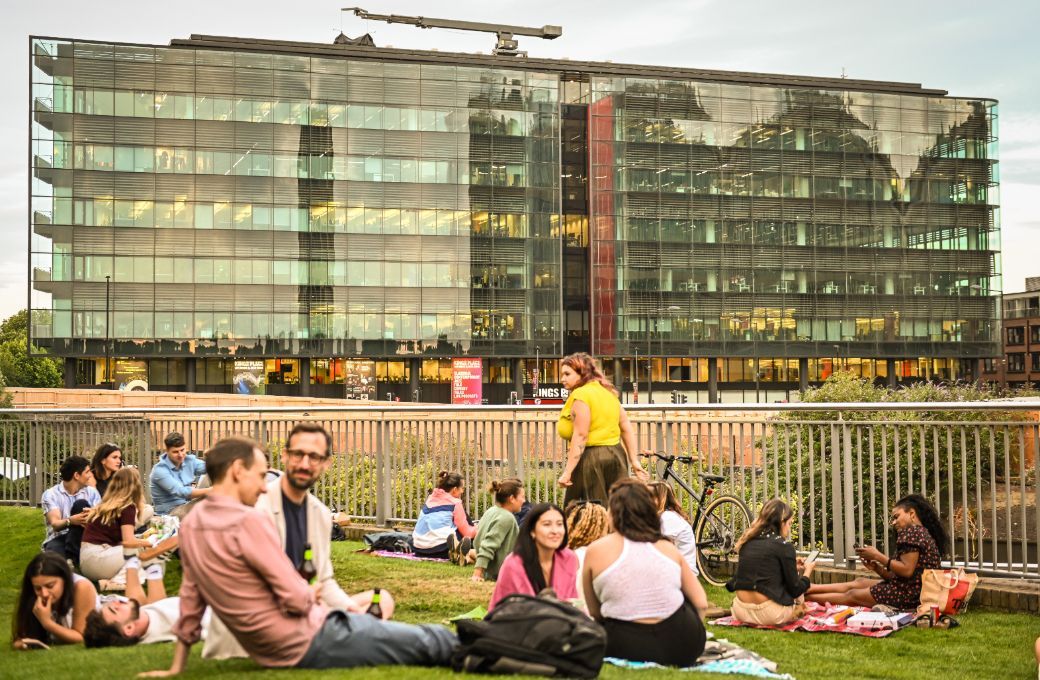Time is stretchy and elastic, more like a rubber band than a ruler. It feels hard to believe, and yet easy to recall, that the district north of King’s Cross in London was once not a place to linger, let alone a destination in its own right. Until the turn of the millennium, Londoners and tourists alike would sit tight on the Northern line between Kings Cross and Camden rather than venture through a sprawl of wasteland and warehouses.

During the past quarter-century, the pace of change and development has been dizzying. Bounded by York Way to the east and the old gasholders to the west, residential and commercial developments now sit cheek by jowl with the local workplaces of companies defining our present and our future: Google, Astra Zeneca, Universal Music. Snaking through the district’s southern end, the Regent’s Canal is no longer a graveyard for shopping trolleys and bicycles – after many years of careful restoration, the canal is now a busy waterway for floating bars, bookshops and tourist boats. On a dry weekend afternoon, the canal banks and paths buzz with Londoners making the most of precious time off.
As the cultural hub of the district, the Kings Place arts complex embodies a spirit of confidence: a reference point on the artistic landscape of London, an established venue for music and the spoken word, and yet one unburdened by history and tradition. Twenty years on from the cranes and diggers getting to work, Kings Place holds to the vision of its original developer, Peter Millican, as a shared space for business and the arts.
Millican has talked about “placemaking”, and it’s a word that clearly applies to redevelopment of the area as a whole. From its home on the north side of Granary Square, Central Saint Martin’s University of the Arts carries forward London’s rich history as a melting pot for visual artists with new ways of seeing and new visions of the world around them.
Kings Place was the first public concert hall to be built in central London since the completion of the Barbican’s facility in 1982. In a telling sign of its success and staying power, others have followed suit, such as Milton Court and Bechstein Hall. Unique to Kings Place, however, is the breadth of programming and – perhaps more saliently – the nature of the space as embedded within the forward-looking energy of its environment.
Together with concert venues Hall One and Two downstairs, Kings Place is also home to the Pangolin Gallery, bringing together visual art and sculpture with music, words and ideas from around the world. Cuisine isn’t excluded either: the integrated Rotunda restaurant bar offers an enviable waterside spot for either pre- or post-concert dining.
Since its inauguration in 2008, Kings Place itself has expanded the possibilities as well as the identity of a modern city space for the arts. The Germans have a good word for it: Kulturpalast. The concept of a culture palace, for them, is not synonymous with gated exclusivity. Instead, as at Kings Place, it defines a space of artistic distinction, freely available and open to all.
Indeed, Kings Place is a microcosm of the new King’s Cross, with offices and culture sitting right alongside one another. The complex still houses the offices of the Guardian newspaper, as well as other companies. If you live nearby, or travel there as a destination point, you can walk in off the street, and within a few minutes be immersed in the culture that suits you, whether that’s the silent and intense appreciation of a Shostakovich quartet or an interactive exchange of ideas at the venue’s annual Podcast Festival.
At a time when boundaries between leisure and work are more blurred than ever, and urban lifestyles are atomised to a degree unimaginable even 25 years ago, the schedule and diary of events at Kings Place no longer marches to the antique beat of a concert-evening drum. Some concerts and other events are hour-long, no-interval affairs, staged twice in an evening, to catch both the after-work and the post-dinner audiences.
Launched in 2009, the ‘Unwrapped’ theme has lent both a stable core and a distinctive shop window to the programming of each season at Kings Place. After Unwrapping Mozart, Bach and Beethoven, Minimalism Unwrapped (2015) won a Royal Philharmonic Society Award. Since then, the violin, the voice and the cello have all been ‘Unwrapped’ across the course of a season, allowing for the kind of patient exploration of a big theme which draws audiences back for a fifth and sixth visit. It’s a strategy that also instils the precious value of loyalty to a venue – something relatively alien to London’s consumer-conscious cultural scene.
The ‘Unwrapped’ series has gone from strength to strength, embracing the local and specific (London in 2021, Scotland in 2024) as well as universal topics: Time in 2018, Venus in 2019, as a celebration of female creativity, and Sound in 2023. This year is the year of Earth Unwrapped, with events to come including further instalments in a year-long exploration of Mahler – that master composer of Naturlaut – by the ever-innovative Aurora Orchestra, a resident ensemble at Kings Place. For listeners young and old who are taking their first steps along Mahler’s huge symphonic journeys, there are multiple weekend performances of ‘Mahler and the Mountain Adventure’, in the ‘Far, Far Away’ series of family events. And the central theme for 2026? Memory Unwrapped.
Back up at street level, beyond the acoustic insulation of Hall One and Hall Two, the activity of Kings Place ripples across the community and the public spaces of Granary Square and Coal Drops Yard. These days, a walk north of King’s Cross is an invitation to linger, to learn and to enjoy life to the full.
Kings Place’s Memory Unwrapped starts in January, with artists in residence Olivia Chaney, GBSR Duo and Renell Shaw. The Brodsky Quartet also present a series, including a performance with Sir Willard White.
See all upcoming events at Kings Place.
Other sites of interest in King’s Cross:
London Canal Museum
Just across the other side of the canal basin from Kings Place, the London Canal Museum is the perfect place to explore the history of London’s waterways, including narrowboat trips and other excursions.
Open Tues–Sun: 10am to 4.30pm. 12-13 New Wharf Road, London N1 9RT
Lightroom
A unique gallery space, fitted out with an array of advanced digital and audio projection technology. Musical highlights at the venue have included Yuja Wang’s collaboration with David Hockney.
Open 10am to 4.30pm/6.30pm. 12 Lewis Cubitt Square, London N1C 4DY
Camley Street Natural Park
On the banks of Regent’s Canal, this inner-city wild corner was created in 1984 from an old coal yard. The visitor centre offers family drop-ins and the Kingfisher Café offers refreshments.
Oct–Mar: 10am to 4pm, Apr–Sept: 10am to 5pm. 12 Camley Street, London N1C 4PW
Wellcome Collection
One of London’s most forward-thinking museums, the Wellcome presents a fascinating dive into topics around health, medicine and the human experience. Temporary exhibitions are well-curated, and the centre also boasts an excellent library.
Open Tues–Sun: 10am to 6pm. 183 Euston Road, London NW1 2BE
Queer Britain
Established in 2018, this first national museum to the LGBT+ community gained its King’s Cross premises in 2022. With free changing exhibitions, the museum bookshop, curated by Gay’s the Word, is a great resource.
Open Wed–Sun: 12pm to 6pm. 2 Granary Square, London N1C 4BH
People’s Museum Somers Town
This unique community museum is organised and curated by local residents, and hosted within the Ossulton Estate. Focusing on the history of the area, including housing, political radicals and reformers, the museum also hosts walks and events.
Open Fri: 9am–5.30pm. 52 Phoenix Road, London NW1 1ES
This article was sponsored by Kings Place.


